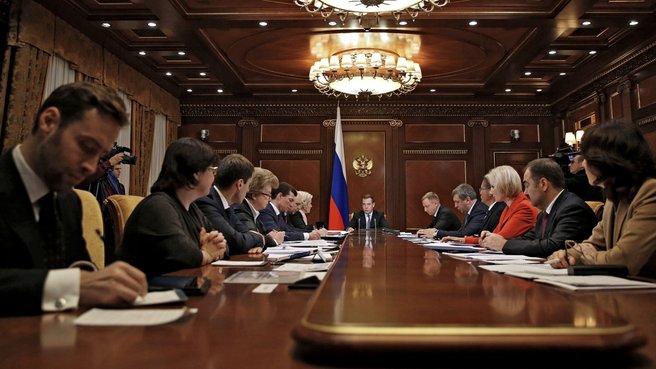Participants in the meeting discussed implementing the maternity capital programme after 2016.
Dmitry Medvedev’s introductory remarks:
Today, we’ll discuss maternity capital, how the programme is administered now and the programme’s future after 2016.
Of course, a lot of families are concerned about this. Everyone is asking these questions everywhere. Ordinary people, not just experts are asking these questions. And, of course, this subject…
I would like to remind you that the programme will run until late 2016, and people are worried about what happens next (they are planning their lives), they want to know whether they should expect the benefit or not, all the more so as we hear proposals, and specific instructions have been issued and the situation has to be resolved.
We’ll discuss the issues, just as we agreed. But we’ll do this with consideration for the fact that the demographic programme remains the most important national programme.
Dmitry Medvedev: "Over 4.5 million families received certificates in 2007-2013. We started paying maternity capital in 2010. Since then, over two million families have applied for the benefit. What does this mean? It means that this popular incentive is quite effective."
Sociological research shows that the birth rate increase over the past six years is largely linked with the introduction of this measure. Maternity capital payments have convinced almost one-third of Russian parents to give birth to second, third and more children.
Over 4.5 million families received certificates in 2007-2013. We started paying maternity capital in 2010. Since then, over two million families have applied for the benefit. What does this mean? It means that this popular incentive is quite effective. By the way, everyone involved in this has looked seriously at specific procedures for making capital payments. These assets have been indexed since the programme’s inception, and this year’s maternity capital is budgeted for 409,000 roubles. This will be bumped to 429,000 roubles in 2014. If you recall, we started with 300,000 roubles; in other words, maternity capital funding has been indexed.
Dmitry Medvedev: "This year’s maternity capital is budgeted for 409,000 roubles. This will be bumped to 429,000 roubles in 2014. If you recall, we started with 300,000 roubles; in other words, maternity capital funding has been indexed."
Of course, other birth incentives are being introduced, including lump-sum childbirth payments and childcare benefits. Seventy-eight Russian regions pay their own maternity capital benefits, which vary, depending on the respective regional budget and demographics. Sixty-five regions have introduced monthly payments for the birth of third and subsequent children. We allocated federal budget funding to 50 regions with the most difficult demographic situations, and the number of these regions will reach 51 in 2014. We provide land plots to families with three and more children. Again, these incentives translate into higher birth rates. In 2013, 10% of Russian families gave birth to third or fourth children. These are good results, but they don’t accomplish the main objective: Despite this trend, we are still failing to ensure a gross reproduction rate. It is also common knowledge that Russia is entering a risk period, and that the number of young prospective mothers will decrease in the next decade. Although the number is estimated using different methods, the experts still generally agree that this will be the trend.
Therefore we have to decide on how these allocations will be used, and we must also decide on selective assistance, all the more so as an absolute majority of people (97%) use these allocations to improve their housing conditions (this includes two-thirds of all maternity capital recipients), including mortgage loans. This is understandable because the housing problem remains the most important public issue. To be honest, when we assessed all this, we proceeded from the fact that this was likely to happen. But perhaps, we didn’t expect 97% of recipients to spend their money on housing.
Dmitry Medvedev: "Seventy-eight Russian regions pay their own maternity capital benefits, which vary, depending on the respective regional budget and demographics. Sixty-five regions have introduced monthly payments for the birth of third and subsequent children. We allocated federal budget funding to 50 regions with the most difficult demographic situations, and the number of these regions will reach 51 in 2014. We provide land plots to families with three and more children."
People spend much less on educating their children and on pension savings. Considering the targeted and selective nature of the maternity capital benefit, we must naturally monitor this spending because it’s being misused in many cases, and because many violations are being recorded. In other words, we need to discuss how this will work going forward. Judging by public sentiment, these decisions will imply that the programme should continue in the same basic direction. But we must also discuss the important financial aspect of it and opportunities for extending this programme, extension deadlines and a number of very important organisational aspects, which are currently in the focus of public attention.
So let’s address these issues.
<…>







